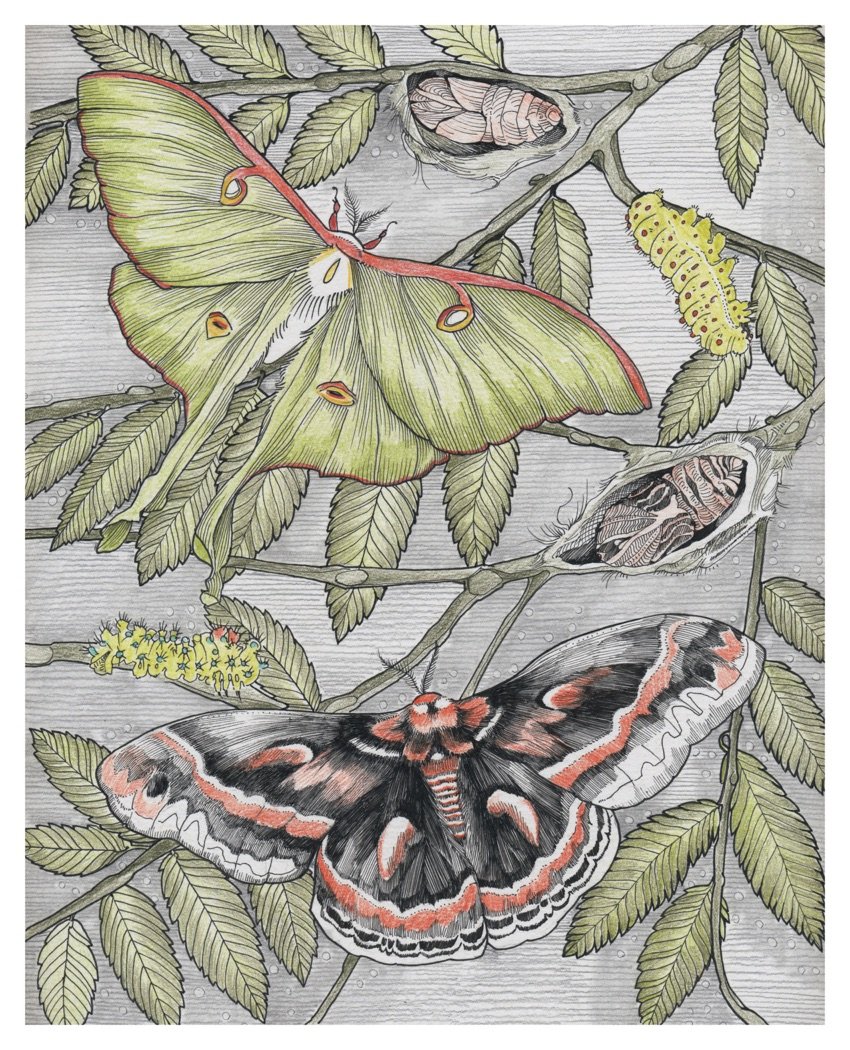 Image 1 of
Image 1 of


MOTHS 8" x 10" print
“Science asks us to learn about organisms. Traditional knowledge asks us to learn from them”. -Robin Wall Kimmerer
This artwork is from a 2022 wall calendar project and is exploring how change happens in the more-than-human world. What is the pace? What is the scale? The catalysts, the intelligence, the resources? The plants and animals are powerful teachers and offer abundant examples of how, specifically, to practice a cooperative, interconnected life. Here I explore examples of Pollination (sharing), Metamorphosis (forming), Germination (growing), and Decomposition (Dying). Each monthly page includes a few questions about how these examples might translate to human experiences.
Metamorphosis: RE-FORMING. MOTHS. Luna and Cecropia Moths are both members of the silk moth family. They go through five stages of molting as caterpillars (Instar larva) and their size and color changes a little each time. As pupae, they are large, dark brown, and encased within a silk cocoon that is attached lengthwise along a stem of a nearby plant. Both types of moth live approximately two weeks in their winged form (Imago). How many rites of passage have you gone through? What helped you find your way through each phase of life?
“Science asks us to learn about organisms. Traditional knowledge asks us to learn from them”. -Robin Wall Kimmerer
This artwork is from a 2022 wall calendar project and is exploring how change happens in the more-than-human world. What is the pace? What is the scale? The catalysts, the intelligence, the resources? The plants and animals are powerful teachers and offer abundant examples of how, specifically, to practice a cooperative, interconnected life. Here I explore examples of Pollination (sharing), Metamorphosis (forming), Germination (growing), and Decomposition (Dying). Each monthly page includes a few questions about how these examples might translate to human experiences.
Metamorphosis: RE-FORMING. MOTHS. Luna and Cecropia Moths are both members of the silk moth family. They go through five stages of molting as caterpillars (Instar larva) and their size and color changes a little each time. As pupae, they are large, dark brown, and encased within a silk cocoon that is attached lengthwise along a stem of a nearby plant. Both types of moth live approximately two weeks in their winged form (Imago). How many rites of passage have you gone through? What helped you find your way through each phase of life?
“Science asks us to learn about organisms. Traditional knowledge asks us to learn from them”. -Robin Wall Kimmerer
This artwork is from a 2022 wall calendar project and is exploring how change happens in the more-than-human world. What is the pace? What is the scale? The catalysts, the intelligence, the resources? The plants and animals are powerful teachers and offer abundant examples of how, specifically, to practice a cooperative, interconnected life. Here I explore examples of Pollination (sharing), Metamorphosis (forming), Germination (growing), and Decomposition (Dying). Each monthly page includes a few questions about how these examples might translate to human experiences.
Metamorphosis: RE-FORMING. MOTHS. Luna and Cecropia Moths are both members of the silk moth family. They go through five stages of molting as caterpillars (Instar larva) and their size and color changes a little each time. As pupae, they are large, dark brown, and encased within a silk cocoon that is attached lengthwise along a stem of a nearby plant. Both types of moth live approximately two weeks in their winged form (Imago). How many rites of passage have you gone through? What helped you find your way through each phase of life?